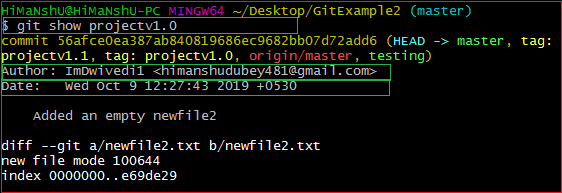

This command is quite versatile and deserves several tips on what it can do, but let’s stick to the task at hand: we want to pull a file’s contents out from a specific revision. Now, you could reset the working directory back to the commit you want to see then look at the file, but that’s lame.Įnter git show, which is an awesome tool for this job. What you want is inside of a blob from whichever commit, so simply saying I want to see this commit won’t cut it. To put it simple, if you are trying to do something like git fetch -p -t, it will not work starting with git version 1.9.4.If you know how Git stores data through blobs, trees, and commits hopefully it should make sense why it’s a bit annoying to get a file from a specific revision out of your repository.
#Git tag show how to#
How to prune local git tags that don't exist on remote Git describe -tags `git rev-list -tags -max-count=1` // gets tags across all branches, not just the current branch Other examples: git describe -abbrev=0 -tags # gets tag from current branch With -abbrev set to 0, the command can be used to find the closest tagname without any suffix: git describe -abbrev=0 Otherwise, it suffixes the tag name with the number of additional commits on top of the tagged object and the abbreviated object name of the most recent commit. If the tag points to the commit, then only the tag is shown. The command finds the most recent tag that is reachable from a commit.

You can also search for tags that match a particular pattern. Just type git tag (with optional -l or -list). Listing the available tags in Git is straightforward. Note: use Git 2.37 with git show-ref -heads/-tags. Similarly, git show -name-only would list the tag and associated commit. Note the -d in order to dereference the annotated tag object (which have their own commit SHA1) and display the actual tagged commit. Which lists tags with their commits (see " Git Tag list, display commit sha1 hashes"). So you are good with your initial command. That being said, Charles Bailey points out that a ' git tag -m "."' actually implies a proper (unsigned annotated) tag (option ' -a'), and not a lightweight one. Normally, you want to at least pass the -a option to create an unsigned tag, or sign the tag with your GPG key via the -s or -u options. Nevertheless, you probably don’t want to push these kinds of tags. Lightweight tags are still useful though, perhaps for marking a known good (or bad) version, or a bunch of commits you may need to use in the future. Without arguments, git tag creates a “lightweight” tag that is basically a branch that never moves. Note: the git ready article on tagging disapproves of lightweight tag.
They’re checksummed contain the tagger name, e-mail, and date have a tagging message and can be signed and verified with GNU Privacy Guard (GPG).
#Git tag show full#
annotated tags: full objects stored in the Git database." version:refname" or " v:refname" (tag names are treated as versions).More recently (" How to sort git tags?", for Git 2.0+) git tag -sort= Typing "git tag" without arguments, also lists all tags. List tags with names that match the given pattern (or all if no pattern is given).


 0 kommentar(er)
0 kommentar(er)
